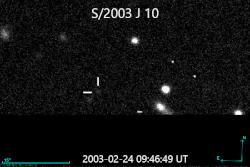S/2003 J 10
 S/2003 J 10 imaged by the Canada-France-Hawaii Telescope during follow-up observations in February 2003 | |
| Discovery [1] | |
|---|---|
| Discovered by | Scott S. Sheppard et al. |
| Discovery site | Mauna Kea Obs. |
| Discovery date | 6 February 2003 |
| Orbital characteristics [2] | |
| Epoch 17 December 2020 (JD 2459200.5) | |
| Observation arc | 80 days |
| 0.1530514 AU (22,896,000 km) | |
| Eccentricity | 0.2065969 |
| –1.94 yr (–707.78 d) | |
| 326.41121° | |
| 0° 30m 31.071s / day | |
| Inclination | 163.48126° (to ecliptic) |
| 241.82190° | |
| 270.05055° | |
| Satellite of | Jupiter |
| Group | Carme group |
| Physical characteristics | |
Mean diameter | ≈2 km[3] |
| Albedo | 0.04 (assumed)[3] |
| 23.6[3] | |
Absolute magnitude (H) | 16.8[2] |
S/2003 J 10 is a retrograde irregular satellite of Jupiter. It was discovered by a team of astronomers from the University of Hawaii led by Scott S. Sheppard et al. in 2003.[4][1]
S/2003 J 10 is about 2 kilometres in diameter, and orbits Jupiter at an average distance of 22,700 Mm in approximately 700 days, at an inclination of 164° to the ecliptic, in a retrograde direction and with an eccentricity of 0.34.
It seems to belong to the Carme group.
This moon has not been seen since its discovery in 2003 and is currently considered lost.[5][6][7][8]
References[]
- ^ a b MPEC 2003-E29: S/2003 J 9, 2003 J 10, 2003 J 11, 2003 J 12; S/2003 J 1, 2003 J 6 2003 April 3 (discovery and ephemeris)
- ^ a b "M.P.C. 128893" (PDF). Minor Planet Circular. Minor Planet Center. 27 January 2021. Retrieved 23 February 2021.
- ^ a b c S.S. Sheppard (2019), Moons of Jupiter, Carnegie Science, on line
- ^ IAUC 8089: Satellites of Jupiter[permanent dead link] 2003 March 7 (discovery)
- ^ Beatty, Kelly (4 April 2012). "Outer-Planet Moons Found — and Lost". www.skyandtelescope.com. Sky & Telescope. Retrieved 27 June 2017.
- ^ Brozović, Marina; Jacobson, Robert A. (9 March 2017). "The Orbits of Jupiter's Irregular Satellites". The Astronomical Journal. 153 (4): 147. Bibcode:2017AJ....153..147B. doi:10.3847/1538-3881/aa5e4d.
- ^ Jacobson, B.; Brozović, M.; Gladman, B.; Alexandersen, M.; Nicholson, P. D.; Veillet, C. (28 September 2012). "Irregular Satellites of the Outer Planets: Orbital Uncertainties and Astrometric Recoveries in 2009–2011". The Astronomical Journal. 144 (5): 132. Bibcode:2012AJ....144..132J. doi:10.1088/0004-6256/144/5/132.
- ^ Sheppard, Scott S. (2017). "New Moons of Jupiter Announced in 2017". home.dtm.ciw.edu. Retrieved 27 June 2017.
We likely have all of the lost moons in our new observations from 2017, but to link them back to the remaining lost 2003 objects requires more observations a year later to confirm the linkages, which will not happen until early 2018. ... There are likely a few more new moons as well in our 2017 observations, but we need to reobserve them in 2018 to determine which of the discoveries are new and which are lost 2003 moons.
Categories:
- Carme group
- Moons of Jupiter
- Irregular satellites
- Lost natural satellites
- Astronomical objects discovered in 2003